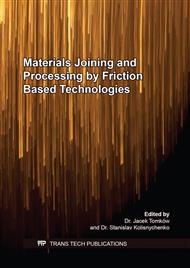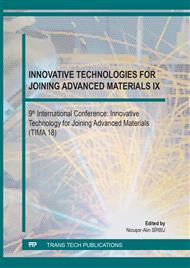p.58
p.64
p.78
p.85
p.92
p.98
p.103
p.108
p.113
Research on the Welding Behavior for Alloy EN AW 5754 when Using FSW-US Hybrid Process
Abstract:
We approached a new hybrid technology that integrates ultrasonic energy with FSW welding. By integrating ultrasound in the FSW process, a number of benefits are expected in terms of welding quality, forces and tool life. Our research aimed at developing a new technique of friction stir welding assisted by ultrasonic energy, namely FSW-US, which can improve the process, it can contribute to the decrease of forces that develop during the welding process and can increase the quality of welded joints. Metal welding and processing technologies that use ultrasonic vibrations, either as a primary source to achieve prescribed performance, or as a source of assistance to improve the efficiency of the operation and product quality, are currently being researched or discussed in the international scientific environment. The present paper analyzes the effects of overlapping ultrasonic vibrations with heat generation, temperature distribution and material flow generated by applying the FSW process. Mechanical effect plays a dominant role in the welding process assisted by ultrasonic vibrations, while thermal effects are insignificant. Overlapping ultrasonic vibrations on the friction stir welding process can produce a stream of improved plasticized material, increases the welding speed and efficiency, it can also improve weld quality by increasing the flow / volume of plastic material around the tool. [1]
Info:
Periodical:
Pages:
92-97
Citation:
Online since:
May 2019
Keywords:
Price:
Сopyright:
© 2019 Trans Tech Publications Ltd. All Rights Reserved
Share:
Citation:



